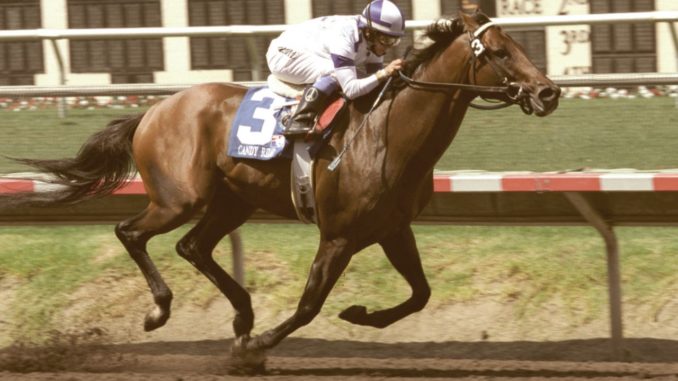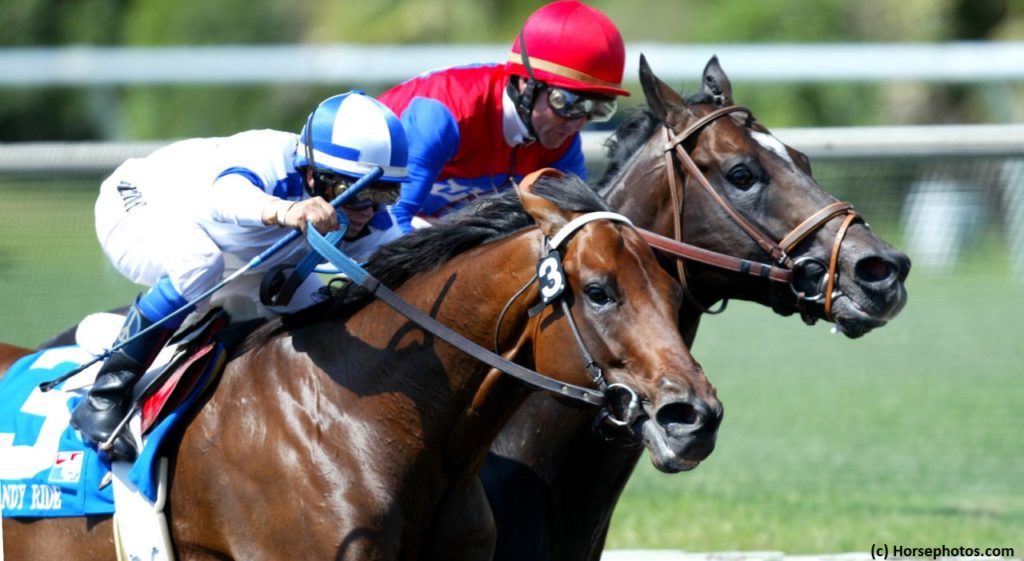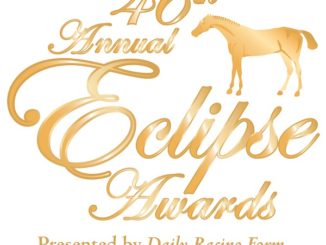
Pacific Classic: Candy Ride vs Medaglia d’Oro
Races become memorable because of the caliber of the performances turned in by exceptional horses, and the 2003 Pacific Classic (G1) certainly qualifies on that score. Argentine import Candy Ride’s track-record victory over Medaglia d’Oro, advancing his career record to a perfect six-for-six, is one to savor in itself.
But that edition of Del Mar’s signature contest has added layers of meaning. First, it was the fruition of a long-range plan by Hall of Fame trainer Ron McAnally, who scouted out Candy Ride as a Pacific Classic prospect when he was still in Argentina. The 2003 Pacific Classic also takes on new luster in hindsight, as the top two have both gone on to become sires of major import.
HANSON: Higher Power scales new heights in Pacific Classic
Although Candy Ride brought an undefeated resume into the Pacific Classic, Medaglia d’Oro was the one to beat on form. The veteran of the 2002 Triple Crown trail, who had been denied narrowly in the Belmont (G1) and gained compensation in the Travers (G1), subsequently compiled a three-race winning spree comprising the Strub (G2), Oaklawn H. (G2), and Whitney H. (G1). Hence Medaglia d’Oro rated as the 3-5 favorite at Del Mar.
In contrast, Candy Ride had yet to try 1 1/4 miles, or a rival of Medaglia d’Oro’s stature. He was also just three years old, with his actual birthday not coming up until September 27. What he did have, however, was the rare ability to travel at a high cruising speed yet still have plenty left to draw off.
Bred by Haras Abolengo, Candy Ride was initially a bargain buy by Gunmercindo Alonzo. According to pedigree guru Sid Fernando (in a Thoroughbred Daily News column on March 10, 2019), the yearling Candy Ride did not pass muster in two vet exams, and Alonzo scooped him up for about $12,000. Whatever physical limitations had been flagged by the veterinarians didn’t slow him down on the racetrack.
Candy Ride crushed all three starts in his homeland by a combined tally of 28 lengths. Unveiled in an about six-furlong dirt maiden at Palermo on August 9, 2002, he romped by 12 lengths in 1:09.31.
The three-year-old proved he was something out of the ordinary when stepping up to Group 1 company, and facing older horses, over a metric mile on turf. After an eight-length conquest of the Gran Premio San Isidro (G1), Candy Ride turned the double in the marquee mile event, the Gran Premio Joaquin S. de Anchorena (G1), by the same margin.
His time was considerably faster on the Anchorena’s quicker surface – 1:31.01 – compared to 1:32.16 in the San Isidro over a rain-sodden course. Reportedly Candy Ride just missed the world record of 1:31 established by Riton in 1995.
At this point McAnally took notice. Forever associated with Hall of Famer John Henry, McAnally was also well known for his success with Argentinean recruits, including Hall of Famers Paseana and Bayakoa. He’d landed Paseana for Sid and Jenny Craig, and saw in Candy Ride a chance to give the Del Mar denizens a long-desired Pacific Classic trophy.
McAnally, speaking to Steve Schuelein for a profile in the October 2014 Trainer Magazine, recalled how it transpired:
“I drove down to Del Mar that January to Sid Craig’s office, showed him a tape of Candy Ride winning a race in Argentina, and said, ‘If you’re ever going to win the Pacific Classic, this is the horse.’”
The pitch was effective, and the Craigs privately acquired Candy Ride for an oft-reported sum of $900,000.
Theoretically Candy Ride might have been vulnerable in his U.S. debut in a June 7, 2003, allowance at Hollywood Park. Returning to dirt in first start off the nearly six-month layoff, he also became embroiled in a pace battle through fast fractions in the 1 1/16-mile affair. But the 7-5 favorite found another gear in the stretch to stamp his class by three lengths in 1:41.28.
Candy Ride reverted to turf for the 1 1/8-mile American H. (G2), where he justified even-money favoritism. His tactical foot enabled him to neutralize the chief weapon of his most dangerous opponent, Special Ring, and he wore down the pacesetter by three-quarters of a length in 1:46.20.
Hall of Fame rider Gary Stevens expected to employ a similar game plan against Medaglia d’Oro in the Pacific Classic. He never got the chance, thanks to injuries sustained in his spill from Storming Home in a wild finish to the Arlington Million (G1).
Instead, it was another Hall of Famer, Julie Krone, who executed the tactic to perfection. She had overcome serious injuries herself during her career – indeed in that same season, not long after launching her comeback in 2002 from retirement.
Krone credited Stevens with giving her valuable insight into Candy Ride. In so doing, Stevens lived out in reality a scene he’d acted in the movie Seabiscuit, only here the roles were reversed. Stevens in the film had portrayed legendary jockey George Woolf, who was counseled by Seabiscuit’s sidelined rider, Red Pollard, played by Tobey Maguire.
Now Stevens was advising Krone on how to maximize Candy Ride’s chances. He was very much on the same page as McAnally, the point being to prevent Medaglia d’Oro, and Hall of Famer Jerry Bailey, from having things their own way.
“We had a Gary Stevens-Tobey Maguire moment,” Stevens said, as recounted in Hank Wesch’s Del Mar: Where the Surf Meets the Turf.
“I just wanted her to know that you could run this horse to San Francisco and back. She breezed him the other day, and she felt the power. But she needed to know how fit he was. The main thing I told her was if Bailey tries to sneak away at the half, just attack. It’s like a match race when you’re seeing how good your competition is. Take the battle to them. And the race was over at the three-eighth pole. She rode him to a ‘T.’”
While two other runners lined up, two-time Santa Anita H. (G1) hero Milwaukee Brew and Japan Cup Dirt winner (G1) Fleetstreet Dancer, the Pacific Classic did unfold as a virtual match race.

Candy Ride, the 2-1 second choice, took a bobble out of the gate, but the athletic colt was quickly into stride and perched on Medaglia d’Oro’s flank. The favorite dictated fractions of :23.40, :46.82, and 1:10.95, traveling comfortably. So was Candy Ride.
Rounding the far turn, Candy Ride drew alongside, and for the first time, Medaglia d’Oro had to be nudged to respond. Krone had yet to ask her mount for his best. As soon as she gave him the cue swinging into the stretch, Candy Ride took off and left Medaglia d’Oro in his wake.
Krone only had to keep him on task down the lane, and the Argentine sensation crossed the wire 3 1/4 lengths clear. He also eclipsed the track record set by Bertrando in the 1993 Pacific Classic, 1:59.55, when stopping the timer in 1:59.11.
“Everybody wanted to find out just how good (McAnally’s) horse was,” Bailey said in the Blood-Horse race recap. “Well, we found out. He’s pretty damn good.”
Krone’s postrace quotes in the Blood-Horse were effusive:
“Amazing. Unbelievable. You just can’t measure something like this. There is not a way to put a scale on it. It is the sweetest. I feel like I can fly. After this, I can do anything.
“How good a horse is he? Wow! That’s how good a horse he is. Amazing. He is a rocketship. I still can’t believe this is real. Pulling up, I asked the pony rider to pinch me. I asked the clerk of scales if this was really happening.
“I’ve got to thank Gary (Stevens). He was a big part of this today. He shared his knowledge of this horse with me, told me about some of his idiosyncrasies. He shares in this win.”
Unfortunately, Candy Ride never raced again. McAnally wanted to give him time off, and the Craigs would have had to pay $800,000 to supplement him to the Breeders’ Cup in any event. A hoped-for 2004 campaign didn’t materialize after ankle issues kept him on the sidelines, and he retired unbeaten, if with a sense of what-might-have been.
Medaglia d’Oro went on to place second in the Breeders’ Cup Classic (G1) for the second straight year, this time to Pleasantly Perfect. The rivals reprised their finish in the 2004 Dubai World Cup (G1), which turned out to be Medaglia d’Oro’s final start.
Candy Ride entered stud at Hill ‘n’ Dale, and a few years later moved to his current home at Lane’s End. A descendant of the Fappiano male line via Cryptoclearance and Ride the Rails, he’s become an enduring success as a sire.
His leading progeny include Horse of Year Gun Runner, last year’s champion juvenile colt Game Winner, and 2013 two-year-old champion Shared Belief. When Shared Belief added the 2014 Pacific Classic to his record, Candy Ride and he became the only father/son tandem so far to capture the Del Mar feature. Another son, Mastery, could have been the story of the 2017 Triple Crown, if not for a career-ending injury in his Pyrrhic San Felipe (G2) victory.
Now Candy Ride’s influence is extending to the next generation as his son Twirling Candy is enjoying a banner year as a sire. Himself a Craig homebred who reflected his sire’s surface versatility, Twirling Candy is responsible for top three-year-old turf filly Concrete Rose, Santa Anita H. (G1) winner Gift Box, Queen’s Plate scorer One Bad Boy, and just this past weekend, his Collusion Illusion took the Best Pal (G2) and Law Abidin Citizen got up in the Longacres Mile (G3).
Medaglia d’Oro has likewise compiled a glittering record at stud, siring Horse of the Year Rachel Alexandra; two-time champion Songbird; Canadian Horse of the Year Wonder Gadot; international turf stars Talismanic, the 2017 Breeders’ Cup Turf (G1) winner, and Vancouver, hero of Australia’s coveted Golden Slipper (G1) in 2015; and current $2 million-earner Elate.
As that list implies, Medaglia d’Oro offers versatility himself, exemplified in dual-surface Grade 1 victor Mshawish. The scion of the Sadler’s Wells line has time to emerge as a sire of sires too, with Violence his latest son to attract attention at stud through the likes of Feedback and recent Gran Premio Estrellas Classic (G1) victor Dandy Del Barrio.
Thus the 2003 Pacific Classic continues to resonate with racing fans and bloodstock enthusiasts alike, as a spectacle showcasing elite athletes who became world-class sires.
For the best gauge of Candy Ride’s talent, look no further than McAnally.
“Every time I clock him in the morning, my hand trembles,” the Hall of Fame horseman told Larry Bortstein in the New York Times of August 25, 2003.
The summation was given to Daily Racing Form’s Jay Privman on August 31, 2004, upon Candy Ride’s retirement:
“He’s as good a horse as I’ve ever trained.”



